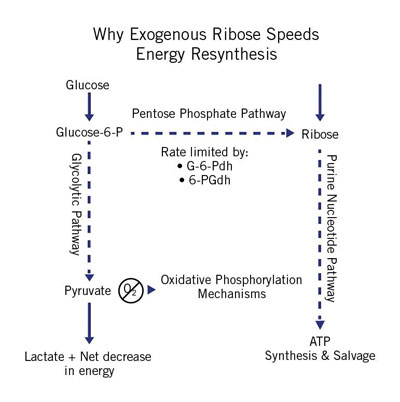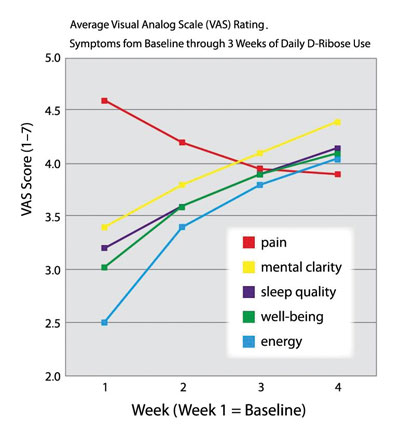
Do you have patients with chronic fatigue syndrome, fibromyalgia,
myocardial dysfunction, low energy . . . or who simply complain they
just feel like they are “out of gas”?
Do you have patients with chronic fatigue syndrome, fibromyalgia, myocardial dysfunction, low energy . . . or who simply complain they just feel like they are “out of gas”?

|
|
These are not uncommon conditions and complaints presenting in most health-care provider’s offices, and although the causes are often multi-factorial – possibly including stress, lack of rest, poor diet and exercise regimes – one must not forget the role the mitochondria might play.
MITOCHONDRIA – A BIOGRAPHY
The mitochondria, known as the powerhouse of the cell, are the key organelles responsible for providing 95 per cent of all the energy requirements in the body. To revisit basic biochemistry, it is in the mitochondria that the majority of adenosine triphosphate (ATP) is made via oxidative phosphorylation in the electron transport chain. The heart, brain, skeletal muscle and sperm have the highest energy requirements in the body and therefore have the highest concentration of mitochondria.
The mitochondria are inherited from our maternal lineage. Both our genetic makeup and our environment affect their function. Mitochondrial dysfunction, and its role in disease states, is becoming much more recognized. Several diseases such as Alzheimer’s, Parkinson’s, MS, infertility, chronic fatigue syndrome and fibromyalgia have been linked to mitochondrial disorders. Mitochondrial dysfunction has also been clearly demonstrated in the lymphocytes of those with autism.
Depressed mitochondrial function is seen in over 60 per cent of fibromyalgia and chronic fatigue patients. The cells have a reduced concentration of ATP and hence are left energy depleted. This results in fatigue, muscle pain, brain fog, sleep abnormalities and a reduced quality of life.
Proper muscle relaxation, which actually is a very active process, requires energy. When metabolism slows and the body’s ATP is low, muscle goes into contracture (rigor mortis) rather than relaxation. ATP is required for the disassociation of actin and myosin that is seen in muscle relaxation. When muscle cells are depleted of their energy stores, the result is calcium retention in the cell and the stimulation of pain receptors by potassium. This all leads to pain, muscle tension and stiffness, and a reduction in exercise tolerance. The same principles apply to cardiac myocytes. Energy depletion in cardiac muscle has been described in heart failure for several decades.
HOW DO WE KEEP ATP LEVELS UP?
We produce ATP mainly via oxidative phosphorylation. This requires substrates that are controlled at the pentose phosphate pathway, which takes glucose-6-phosphate to ribose. The rate limiting step occurs at this conversion via glucose-6-phophate dehydrogenase and 6-phosphogluconate dehydrogenase. In summary, without reviewing too much biochemistry, if we cannot produce enough substrate, the whole process slows down, resulting in low levels of ATP. The activity of these rate limiting enzymes is often poorly expressed in many tissues and is also compromised by chronic metabolic stress. This results in many cells being left without the ability to regenerate their energy supply. This is where a key nutrient, d-ribose, can make significant impact.
 |
WHAT IS D-RIBOSE?
D-ribose is a naturally occurring energy regulating compound in ATP. It is a “structural” sugar and although it is a sugar, it is significantly different and metabolized differently than glucose, fructose and sucrose. While these other sugars increase blood glucose levels, stimulating large insulin spikes and fat deposition, ribose does not. Ribose, when taken alone, may actually cause a small transient decrease in blood sugar levels. Also important in producing ATP is the salvage pathway of adenine nucleotides – d-ribose helps in regulating these pathways and restoring cellular energy.
There have been very encouraging studies on the use of d-ribose and the improvement of energy production. Tietelbaum, McGrew and Jandrain conducted a multicentre study using d-ribose supplementation with chronic fatigue and fibromyalgia patients. In just four weeks, patients reported a 61 per cent improvement in energy, while also reporting improvement in sleep quality, mental clarity, general well-being and pain reduction. Dosing for this group is recommended at 5 g, three times daily for two weeks, and then reduced to 5 g twice daily.
 |
Other studies have looked at the role of d-ribose in cardiac function. Clinical data showed an increase in hypoxic threshold, improved diastolic heart function, increased exercise tolerance and improved oxygen utilization efficiency when supplemented with d-ribose.
OTHER NUTRIENTS TO ENHANCE MITOCHONDRIAL FUNCTION
Coenzyme Q10 is an essential cofactor in the mitochondrial respiratory chain, and hence affects ATP production. Most supplementation is noted at 100 mg per day; however, the neurodegenerative doses used in Parkinson’s disease suggest 1,200 mg per day. The role of pyrroloquinoline quinone (PQQ) is also being investigated, with encouraging results. It has been shown in rodent studies that a deficiency in PQQ decreases the size, number, and function of mitochondria, whereas supplementation with PQQ reversed these effects.
Essential fatty acids play many positive roles in the body but their role in maintaining healthy membranes is well accepted, and very relevant to the mitochondria. Healthy membrane structures are essential in mitochondrial health, considering the vast membrane area of the cristae in the mitochondria.
It would be neglectful not to mention the role of exercise in mitochondrial health. Exercise can increase both the health and mass of the mitochondria in skeletal muscle. Of course, the energy to exercise must first be addressed in the fatigued patient – this is where providing a substrate like d-ribose may benefit as a starting point.
Energy production, the mitochondria and the role substrate supplementation plays in cardiovascular health and improved athletic performance have been researched in the past, with positive outcome. Mitochondrial health and the ability to enhance its function, especially in conditions such as fibromyalgia and chronic fatigue syndrome, are encouraging. You can assist your patients in putting a little more “gas in their tank” and improve their energy output, and hence, quality of life. •
References
- Bauerly KA, Storms DH, Harris CB, Hajizadeh S, et al. Pyrrologquinoline quinone nutritional status alters lysine metabolism and modulates mitochondrial DNA content in the mouse and rat. Biochim Biophys Acta. 2006;1741-8
- Gebhart B, JA Jorgenson. Benefit of ribose in a patient with fibromyalgia. 2004;24(11):1646-1648
- Neubauer S. The Failing Heart-An engine out of fuel. N Engl J Med 2007;356:1140-51
- Omran H, S Illien, D MacCarter. JA St. Cry. B Luderitz. D-Ribose improves diastolic function and quality of life in congestive heart failure. A prospective feasibility study. 2003;5:615-619
- Shultz J. Update on the pathogenesis of Parkinson’s disease. J Neurol (2008) 255 (suppl 5):3-7
- Stites T, Storms D, Bauerly K, Mah J, et al. Pyrroloquinoline quinone modulates mitochondrial quantity and function in mice. J Nutr. 2006; 136(2):390-6
- Wallen JW.MP Bleanger, C Wittnich. Preischemic administration of ribose to delay the onset of irreversible ischemic injury and improve function: studies in normal and hypertrophied hearts. 2003; 81:40-47
Dr. Victoria Coleman is a 1994 graduate of CMCC and a BSc in Kinesiology specializing in Fitness Assessment and Exercise Counseling. Working with patients over the years, it became her mission to teach people that everything you eat, breath, drink, and think affects your health. This fuelled her desire to further expand her career and continue her studies. She is an avid follower of the Institute for Functional Medicine and is currently working toward her certification in Functional Medicine. Dr. Coleman is also the president of Douglas Laboratories/Pure Encapsulations Canada.
Print this page